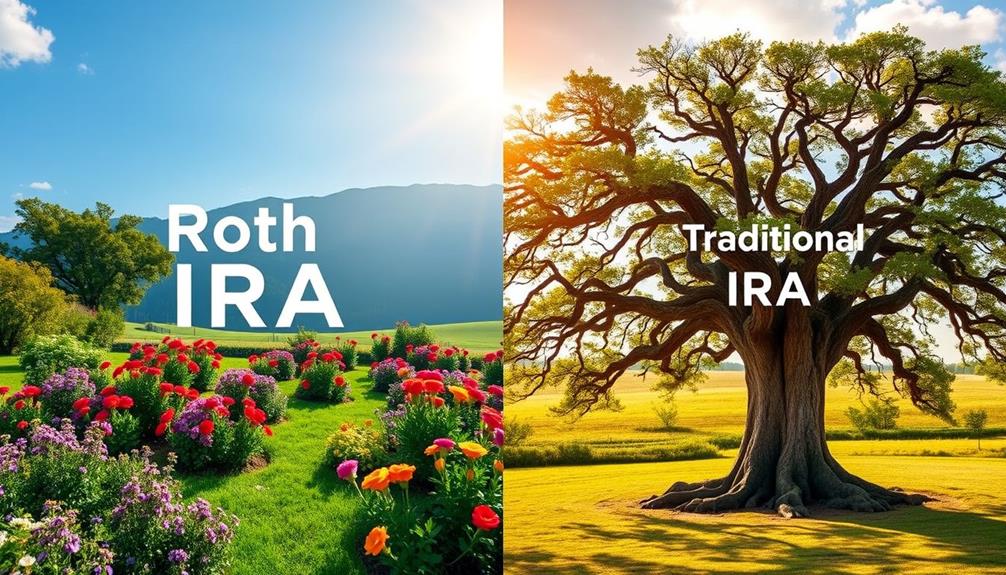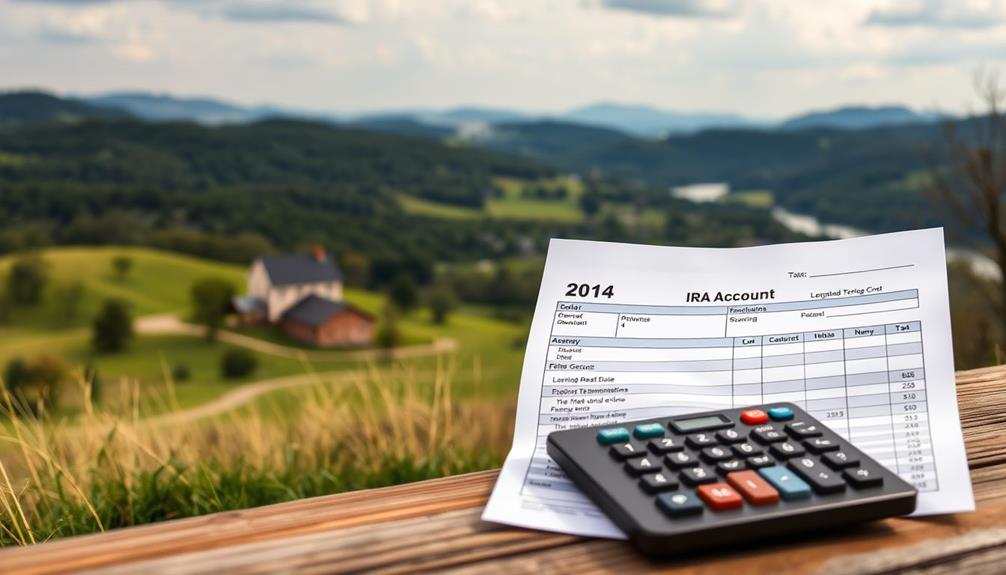To create a well-rounded IRA portfolio, it is important to find a balance between risk and reward. The first step is to assess your risk tolerance in order to create a diverse mix of investments. A common strategy involves allocating 60% to stocks for growth, 30% to bonds for stability, and 10% to cash or alternative assets such as REITs. Diversification across different asset classes is key to reducing risk and maintaining consistent returns. It is essential to regularly review your portfolio and make adjustments as necessary to keep your desired risk level. Seeking guidance from a financial advisor can provide personalized strategies and ongoing support to improve your investment outcomes. There is a wealth of information available to help you optimize your portfolio for long-term success.
Key Takeaways
- Assess your risk tolerance to determine an appropriate mix of stocks, bonds, and other assets for your IRA portfolio.
- Aim for a diversified asset allocation, typically 60% stocks, 30% bonds, and 10% cash equivalents, to balance growth and stability.
- Incorporate alternative investments, like Gold or Bitcoin IRAs, to enhance diversification and protect against economic instability.
- Regularly rebalance your portfolio to maintain desired risk levels and align with long-term financial goals.
- Monitor economic conditions and market trends to make informed adjustments that maximize returns and safeguard investments.
Understanding Risk and Reward

When you're building a diversified IRA portfolio, how do you balance risk and reward? Understanding your risk tolerance is key. It helps you decide how much risk you're willing to take on for potential gains.
A balanced portfolio typically involves a mix of 60% stocks and 40% bonds, which can help mitigate risks while maximizing returns. Stocks offer growth potential, but they come with higher volatility. On the other hand, bonds, especially government bonds, provide fixed returns and a steady income stream, making them safer investments.
Additionally, incorporating alternative assets such as Gold IRAs can enhance portfolio resilience against economic instability.
Diversification is vital in achieving this balance. By spreading your investments across various asset classes like stocks, bonds, and real estate, you reduce the impact of market fluctuations. This strategy enhances the stability of your returns over time, aligning with your financial goals.
Remember that regular portfolio reviews and adjustments are important. As your financial situation and market conditions change, you need to confirm your portfolio remains aligned with your risk tolerance.
Importance of Diversification

When it comes to your investment portfolio, diversification is key for mitigating risk and ensuring stable long-term returns.
By spreading your investments across different asset types, such as precious metals like gold and silver, you reduce the chance that a single poor performer will derail your financial goals.
This strategy not only protects your portfolio during market fluctuations but also enhances your potential for steady growth over time.
Consider exploring options like Noble Gold's investment offerings to further diversify your IRA.
Risk Mitigation Strategies
Diversification is a cornerstone of effective risk mitigation strategies, allowing you to spread your investments across various asset classes like stocks, bonds, and real estate. By implementing a diversified portfolio, you can reduce overall portfolio risk and protect yourself against adverse market conditions.
According to Harry Markowitz's Modern Portfolio Theory, spreading your investments helps mitigate unsystematic risk, which is tied to individual assets. Incorporating alternative investments, such as Bitcoin IRAs, can further enhance diversification and potential returns. Holding a mix of negatively correlated assets can buffer your portfolio during market downturns.
Historical data supports that diversified portfolios tend to outperform concentrated investments over time, providing more stable returns and greater resilience during economic volatility. Financial advisors recommend this approach as a core investment strategy, emphasizing the importance of effective asset allocation.
However, it's vital to strike a balance. Over-diversification can inadvertently increase overall portfolio risk, so aim for 20-30 different investments. This keeps your portfolio manageable while still reaping the benefits of diversification.
Stable Long-Term Returns
A well-diversified IRA portfolio is your key to achieving stable long-term returns. By spreading your investments across various asset classes, you reduce the impact of poor performance from any single investment. This strategy enhances the overall stability of your returns, which is vital for long-term financial success.
Historical data shows that diversified portfolios typically outperform concentrated investments over time, with diversification potentially improving risk-adjusted returns by up to 1-2% annually.
Including a mix of stocks, bonds, and alternative investments like real estate in your IRA can protect you against market volatility. Different asset classes often respond uniquely to economic changes, allowing your portfolio to weather fluctuations more effectively. This principle aligns with Modern Portfolio Theory, which suggests that combining uncorrelated assets can maximize returns for a given level of risk.
To maintain the benefits of your diversified portfolio, it's important to regularly rebalance your IRA. As your investments grow, drifting away from your target allocations can inadvertently increase your exposure to risk without corresponding gains.
Keeping your portfolio aligned with your financial goals will help guarantee stable, long-term returns.
Core Components of a Portfolio

Fundamentally, your IRA portfolio should consist of several core components that work together to balance risk and return. A well-diversified investment portfolio typically includes a mixture of asset classes. Here's a breakdown of a common allocation:
| Asset Class | Percentage Allocation |
|---|---|
| Stocks | 60% |
| Bonds | 30% |
| Cash/Cash Equivalents | 10% |
| International Assets | Varies |
| Real Estate (REITs) | Varies |
Stocks are essential for higher potential returns but come with increased volatility. On the other hand, bonds provide stability and fixed returns, which are important for income generation, especially for retirees. To further diversify your portfolio, consider including international assets, as global markets can react differently to economic changes, reducing overall risk.
Additionally, Real Estate Investment Trusts (REITs) can offer exposure to real estate markets while generating income through dividends. Regularly rebalancing your portfolio—typically every 6 to 12 months—ensures that your asset allocation stays aligned with your risk tolerance and long-term financial goals. This balanced approach is crucial for a successful IRA portfolio.
Strategies for Diversifying Your IRA

When you're looking to enhance your IRA, incorporating a variety of asset classes can greatly reduce risk and improve your potential returns.
To effectively diversify your portfolio, consider these investment strategies:
- Mix asset classes: Include stocks, bonds, and real estate investment trusts (REITs) to spread risk across different sectors.
- Utilize low-cost funds: Invest in index funds or exchange-traded funds (ETFs) for broad market exposure with minimal fees, making it easier to achieve diversification.
- Incorporate international investments: Accessing foreign markets can enhance growth potential and reduce risk through geographic diversification.
- Regularly rebalance your portfolio: Market fluctuations can shift your asset allocation, so rebalancing helps maintain your desired risk level and investment strategy.
While diversifying, assess your risk tolerance and investment horizon to guarantee your choices align with your long-term financial goals.
By thoughtfully diversifying your IRA, you'll not only spread risk but also position yourself for better overall performance in the long run.
Monitoring and Adjusting Your Portfolio

To guarantee your IRA remains aligned with your financial goals, it's important to monitor and adjust your portfolio regularly. Start by reviewing your diversified portfolio at least once a year. This helps confirm that your asset allocations fit your risk tolerance and financial objectives. If market performance or your personal circumstances change, you may need to adjust allocations accordingly.
Implement a systematic rebalancing strategy to maintain your desired asset mix. This could mean selling off high-performing assets and reallocating those funds to underperforming areas, helping to mitigate risk.
Keep an eye on the performance of individual investments and sectors; identifying trends allows you to make informed decisions about necessary adjustments.
Stay informed about economic conditions and market trends. External factors can impact asset classes differently, so your IRA might require timely adjustments to maximize returns.
Additionally, consider using portfolio analysis tools or consulting a financial advisor to assess your diversification levels. This proactive approach to monitoring and adjusting your portfolio plays a vital role in achieving long-term financial success and safeguarding your IRA against market fluctuations.
Seeking Professional Guidance

How can you guarantee your diversified IRA portfolio truly reflects your financial goals? Seeking professional guidance from a financial advisor is a smart move.
They can provide personalized strategies tailored to your unique risk tolerance and investment objectives. Advisors often use tools like risk assessment questionnaires, helping you understand your comfort level with various asset classes before making recommendations.
Here are some benefits of working with a financial advisor:
- Tailored strategies that align with your financial goals
- Enhanced diversification through mutual funds or ETFs, minimizing risks
- Regular check-ins to confirm your portfolio stays balanced amid changing market conditions
- Periodic rebalancing to optimize risk and reward based on current economic trends
Frequently Asked Questions
How Do I Diversify My IRA Portfolio?
To diversify your IRA portfolio, allocate investments across various asset classes like stocks, bonds, and real estate. Utilize low-cost index funds, regularly rebalance your holdings, and consider international investments for broader exposure and reduced risk.
How Do I Rebalance My IRA Portfolio?
You think your IRA's static, but it needs a makeover! Rebalance by selling overperformers and buying underperformers. Check your allocations annually, adjust for market changes, and don't ignore those pesky tax implications.
Can Risk and Reward Be Balanced Through Diversifying?
Yes, you can balance risk and reward through diversification. By spreading your investments across various asset classes, you reduce the impact of market volatility, aiming for more stable returns while maximizing your potential gains.
What Is the 70 30 Investment Strategy?
The 70/30 investment strategy combines 70% in equities for growth and 30% in bonds for stability. You'll balance potential returns while mitigating risk, aligning with a moderate investment approach that suits your financial goals.
Conclusion
Balancing risk and reward in your IRA portfolio is like walking a tightrope; it takes careful planning and attention. By understanding the dynamics of risk and the importance of diversification, you can build a resilient portfolio that adapts to market changes. Remember, it's not just about selecting assets but also about regularly monitoring and adjusting your investments. Don't hesitate to seek professional guidance—sometimes, a little expert advice can make all the difference in your financial journey.










